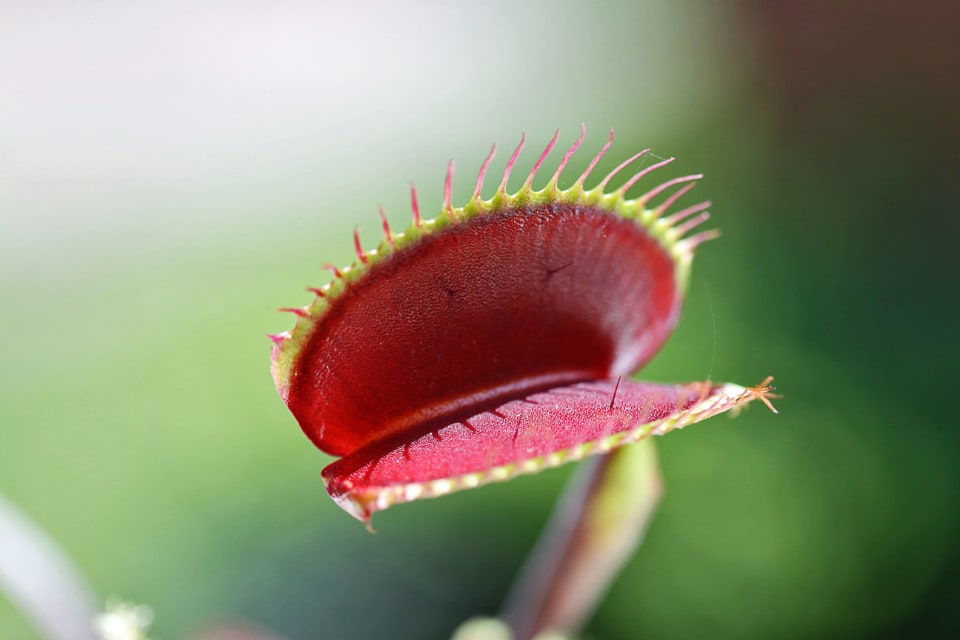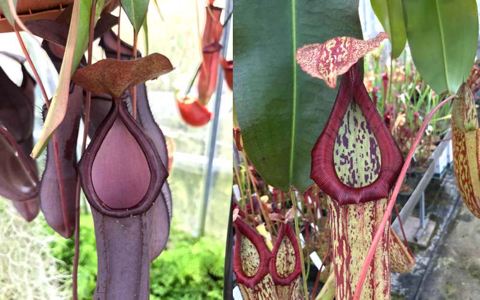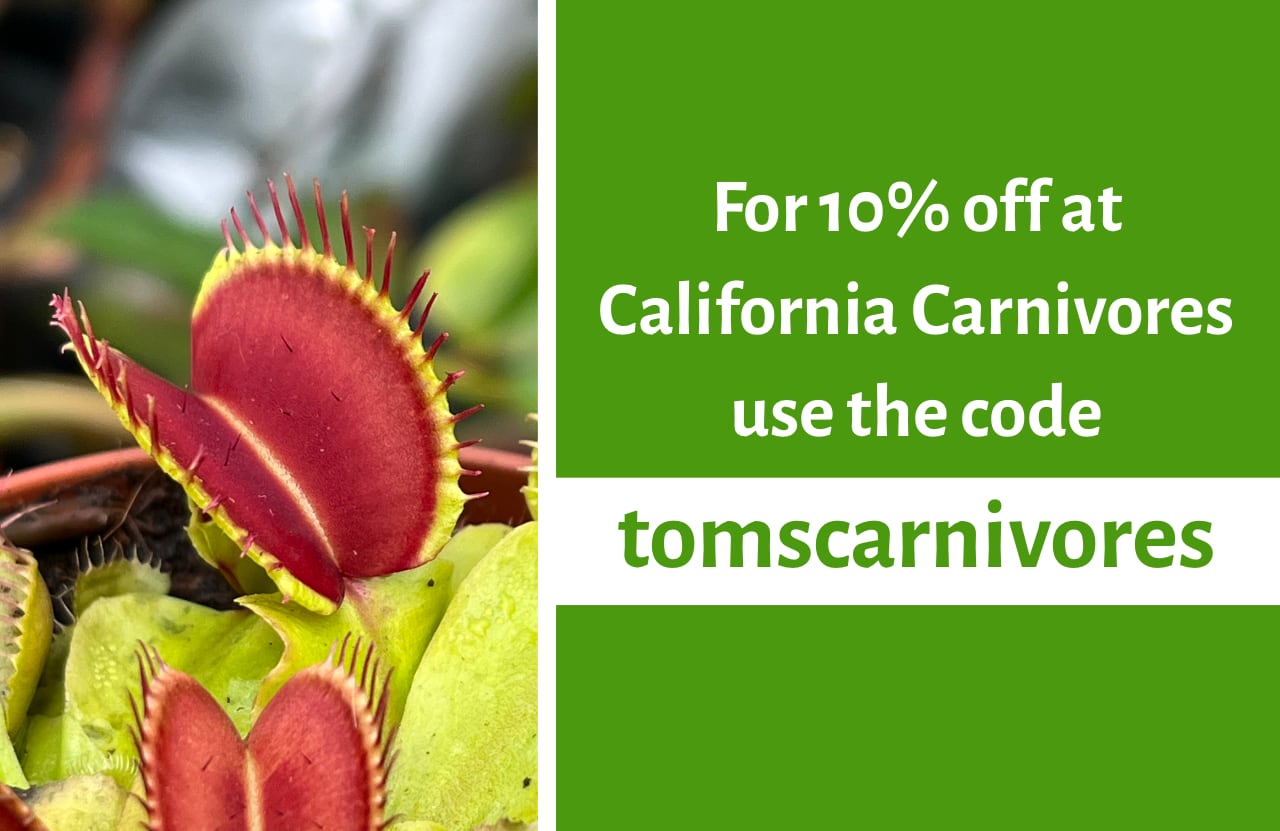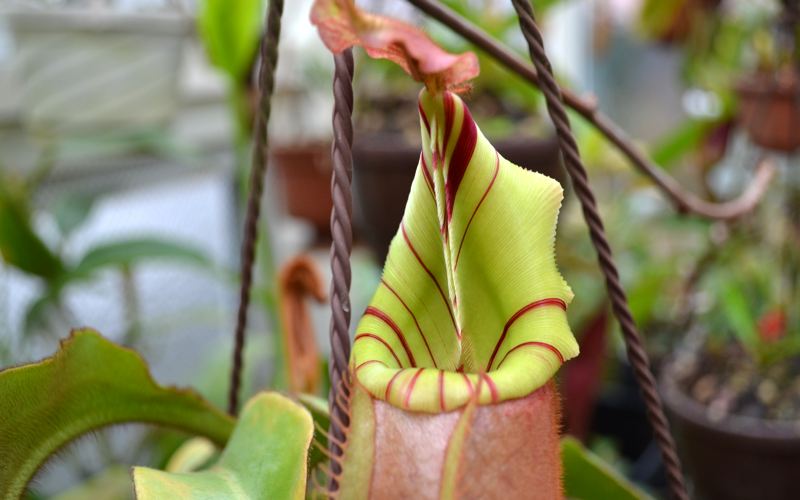
Gallery: Christian Klein nursery tour
Published 21 November 2017, updated
Last week I visited Christian Klein in Germany. Having heard so much about his plants - both from nursery owners and fellow hobbyists - I was very excited to see his collection for myself.
The growing season for temperate plants like Sarracenia was of course over, but Chris was kind enough to show me round his tropical greenhouse. Here he grows Nepenthes, Heliamphora, Cephalotus, tropical Drosera, as well as a wide variety of tropical ferns and orchids. I also had the opportunity to ask him a few questions about his nursery business, recent catalog update, and approach to growing CPs. Photos are distributed throughout.
Christian’s Nursery
Christian’s CP business is actually just a hobby. By trade he is a professional landscape gardener, and he operates his CP nursery in his spare time as a family business with his wife Claudia and their two children. “Our daughter is 21 and she makes the seed bank. My son is 18 and he helps - a little bit - with packing.” Looking around at the piles of empty labeled bags, each an unfulfilled order, he adds: “well, sometimes he helps. Not so much today.”
Several days before my visit, Christian had updated his wholesale list, an event which always results in a huge influx of emails and new orders. In lieu of a proper website, he maintains a PDF to publicize plant availability to his distributors - updating this list and fulfilling the subsequent orders has become hugely labour-intensive, which is one of the reasons Christian is in the process of building a new website for distributors to use. This is intended to reduce admin, rather than to grow his business.
“We do not really want to make it bigger,” says Christian, “because we have orders enough! I don’t want to be a complete professional seller, because I am a collector: it’s in my genes.”
Article continues below.
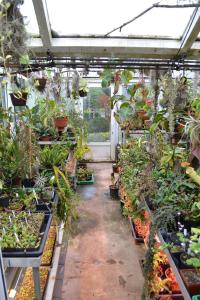 We first entered the main intermediate greenhouse.
We first entered the main intermediate greenhouse.
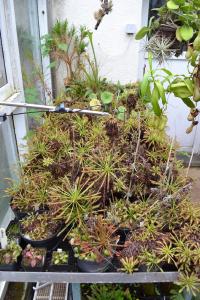 Chris grows many Drosera in here, including various forms of the cape sundew.
Chris grows many Drosera in here, including various forms of the cape sundew.
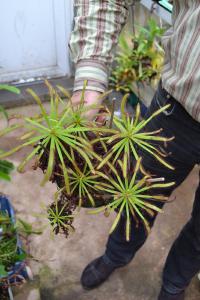 This particular plant resembled a palm tree, with years of dead leaves beneath each rosette forming a kind of stem.
This particular plant resembled a palm tree, with years of dead leaves beneath each rosette forming a kind of stem.
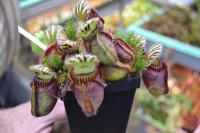 A particularly stunning clone of Cephalotus follicularis, the West Australian pitcher plant. These were probably the largest Cephalotus pitchers I've ever seen.
A particularly stunning clone of Cephalotus follicularis, the West Australian pitcher plant. These were probably the largest Cephalotus pitchers I've ever seen.
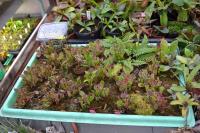 A tray of young Heliamphora growing side-by-side with Nepenthes.
A tray of young Heliamphora growing side-by-side with Nepenthes.
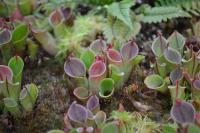 Young Heliamphora plants.
Young Heliamphora plants.
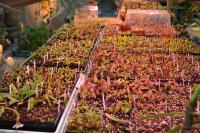 Beneath the benches, Chris grows Nepenthes seedlings under LEDs.
Beneath the benches, Chris grows Nepenthes seedlings under LEDs.
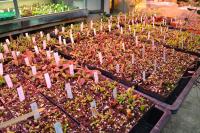 Seedlings of N. veitchii, N. bongso, N. naga, N. copelandii x lowii, and more.
Seedlings of N. veitchii, N. bongso, N. naga, N. copelandii x lowii, and more.
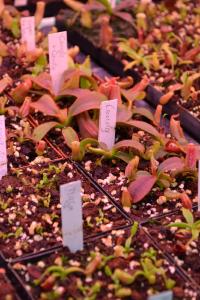 Close-up of some Nepenthes veitchii 'Candy' seedlings. I want one.
Close-up of some Nepenthes veitchii 'Candy' seedlings. I want one.
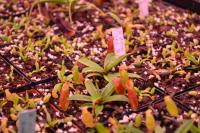 N. dubia seedlings. Chris said that all were sown at the same time, even the notably larger plants.
N. dubia seedlings. Chris said that all were sown at the same time, even the notably larger plants.
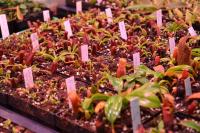 N. lowii and N. macrophylla seedlings.
N. lowii and N. macrophylla seedlings.
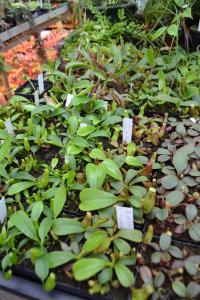 Chris had warned us before we entered the greenhouse that it was 'very full'. That description doesn't quite do it justice - every surface has something growing on it, not to mention the hanging baskets.
Chris had warned us before we entered the greenhouse that it was 'very full'. That description doesn't quite do it justice - every surface has something growing on it, not to mention the hanging baskets.
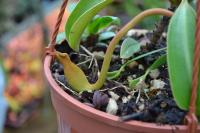 A developing pitcher in a hanging basket plant.
A developing pitcher in a hanging basket plant.
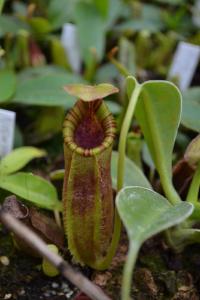 A nice colourful peristome on this young plant - I didn't manage to get a shot of the label.
A nice colourful peristome on this young plant - I didn't manage to get a shot of the label.
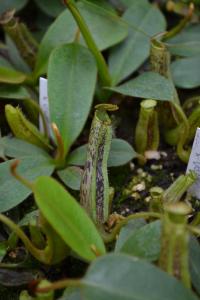 A new hybrid, Nepenthes platychila x vogelii - distinctive vogelii traits even at this small size.
A new hybrid, Nepenthes platychila x vogelii - distinctive vogelii traits even at this small size.
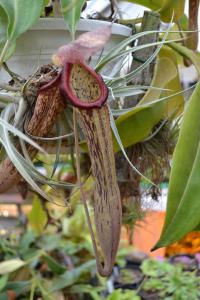 I believe this was Nepenthes boschiana.
I believe this was Nepenthes boschiana.
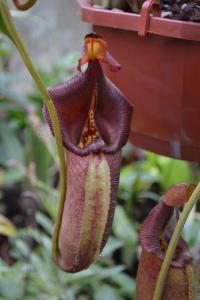 Nepenthes robcantleyi.
Nepenthes robcantleyi.
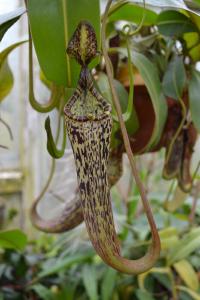 'Nepenthes spec. Murud'. Christian observed that this should be N. vogelii, but clearly it is not - it's more like N. fusca or N. platychila.
'Nepenthes spec. Murud'. Christian observed that this should be N. vogelii, but clearly it is not - it's more like N. fusca or N. platychila.
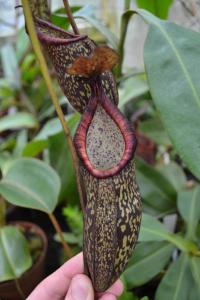 Nepenthes spectabilis x rigidifolia...
Nepenthes spectabilis x rigidifolia...
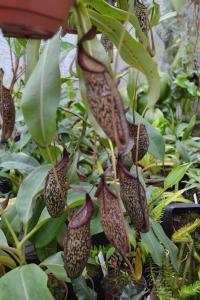 ...which was a prolific producer of pitchers, as you can see.
...which was a prolific producer of pitchers, as you can see.
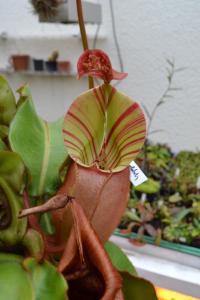 My favourite! A newly-opened pitcher on Nepenthes veitchii 'Candy stripe'.
My favourite! A newly-opened pitcher on Nepenthes veitchii 'Candy stripe'.
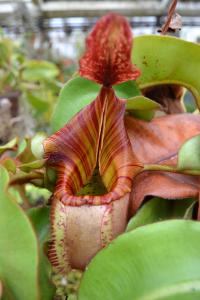 Darkening peristome on Nepenthes veitchii.
Darkening peristome on Nepenthes veitchii.
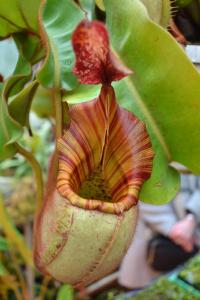 The fuzzy hair which covers the entire pitcher body was particularly evident here.
The fuzzy hair which covers the entire pitcher body was particularly evident here.
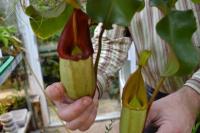 Nepenthes veitchii green form, with yellow peristome darkening to red.
Nepenthes veitchii green form, with yellow peristome darkening to red.
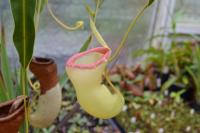 Nepenthes ventricosa porcelain form.
Nepenthes ventricosa porcelain form.
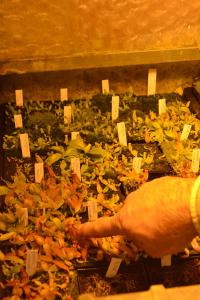 More hybrid seedlings! As Chris pointed out, the distinctive hamata teeth are visible on these N. hamata x thorelli even when young.
More hybrid seedlings! As Chris pointed out, the distinctive hamata teeth are visible on these N. hamata x thorelli even when young.
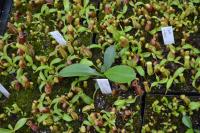 N. spathulata x lowii seedlings. Chris explained that he'd been experimenting with different means of inducing 'leaf jumps', including early repotting and extra osmocote fertiliser.
N. spathulata x lowii seedlings. Chris explained that he'd been experimenting with different means of inducing 'leaf jumps', including early repotting and extra osmocote fertiliser.
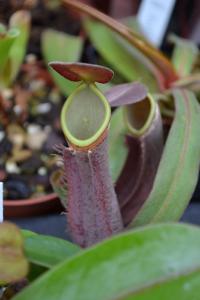 A red form of Nepenthes albomarginata.
A red form of Nepenthes albomarginata.
‘Trendy’ Plants
While chatting about his latest catalog update, we got talking about how certain Nepenthes species and hybrids seem to be in vogue.
“N. lowii is very very sought. It makes no difference what you’ve crossed with N. lowii, everybody wants it!” To a degree this is understandable, given how attractive these hybrids can be. Christian remarked that many are even easy growers. “The species is slow, but the hybrids are much faster. Even N. lowii x ephippiata is much faster to grow, yet you cannot see the difference in a small plant.”
Sometimes, however, this kind of widespread popularity means that more unusual crosses get overlooked. “It’s funny,” says Christian. “I have a new hybrid, N. platychila x vogelii, made by Thomas Schneider, a Nepenthes grower from Germany who has a really nice collection. This hybrid sounds very good but nobody wants it! I have no idea why. It’s such a nice hybrid, and the little plants are looking so nice, but nobody wants it. Cross anything with N. lowii, everybody wants it.”
These ‘crazes’ can come along very suddenly, and to Christian - who is not a social media user - they often seem spontaneous. “Years ago I made a hybrid, N. hurrelliana x veitchii, and at first nobody wanted it. We had hundreds of them.” When word finally got out, they instantly started selling. “It started up, and after a very short time they were all gone, because now everybody wants to have this hybrid. Maybe there was something on Facebook, or somebody online wrote about it - I don’t know!”
Some growers will pay anything to get their hands on a particularly cool plant. N. hamata ‘hairy red’, crosses with N. lowii, candy striped forms of N. veitchii, toothy species like N. edwardsiana, and some N. truncata clones will often go for hundreds of Euros on eBay. I commented on the high price commanded by the (admittedly stunning) N. truncata x lowii specimen offered in the recent Exotica Plants auction. “To be fair,” says Christian, “that is a nice plant. Mine had a pitcher of half a metre: the biggest pitcher in the whole greenhouse.”
Article continues below.
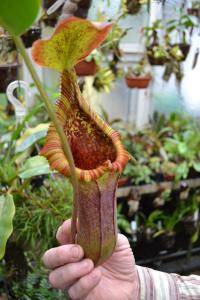 Entering the highland house, we were greeted by this enormous Nepenthes trusmadiensis x truncata 'EP'.
Entering the highland house, we were greeted by this enormous Nepenthes trusmadiensis x truncata 'EP'.
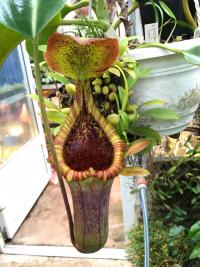 This is one of those hybrids which seems to inherit all the best traits of its parents - the size of N. truncata, the wide open mouth of N. lowii, and the toothy peristome of N. macrophylla.
This is one of those hybrids which seems to inherit all the best traits of its parents - the size of N. truncata, the wide open mouth of N. lowii, and the toothy peristome of N. macrophylla.
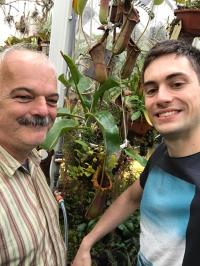 Obligatory selfie with N. trusmadiensis x truncata!
Obligatory selfie with N. trusmadiensis x truncata!
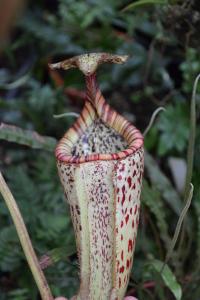 Nepenthes burbidgeae.
Nepenthes burbidgeae.
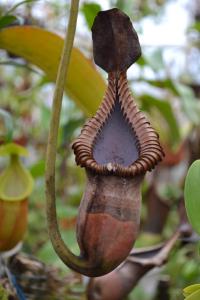 A skeleton of Nepenthes macrophylla.
A skeleton of Nepenthes macrophylla.
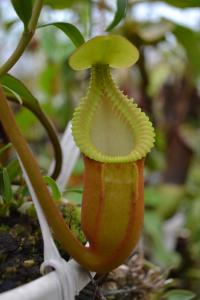 Young Nepenthes macrophylla pitcher.
Young Nepenthes macrophylla pitcher.
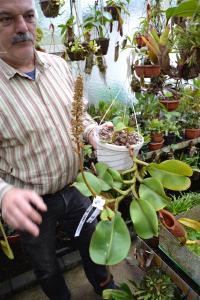 Chris explained that on larger flower spikes, he will segment the flowers to make multiple crosses.
Chris explained that on larger flower spikes, he will segment the flowers to make multiple crosses.
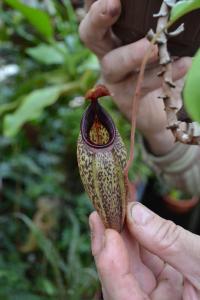 This looked to me like N. aristolochioides x spectabilis, but I can't remember for sure.
This looked to me like N. aristolochioides x spectabilis, but I can't remember for sure.
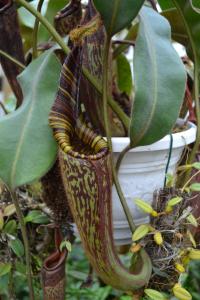 The magnificent Nepenthes hurrelliana.
The magnificent Nepenthes hurrelliana.
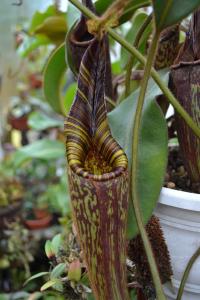 I love this species - a big elongated neck, lovely yellow-brown striped peristome, and covered in veitchii-like hair!
I love this species - a big elongated neck, lovely yellow-brown striped peristome, and covered in veitchii-like hair!
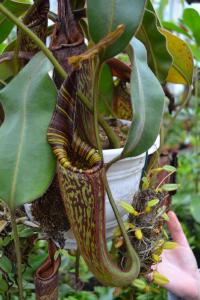 Nepenthes hurrelliana again - the plant was clearly thriving, producing multiple pitchers.
Nepenthes hurrelliana again - the plant was clearly thriving, producing multiple pitchers.
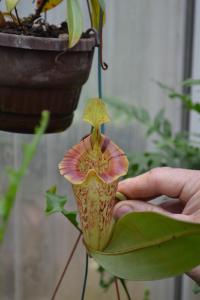 An upper pitcher on Nepenthes platychila.
An upper pitcher on Nepenthes platychila.
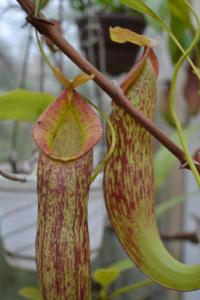 I spotted these pitchers up high - I think they're Nepenthes gymnamphora uppers.
I spotted these pitchers up high - I think they're Nepenthes gymnamphora uppers.
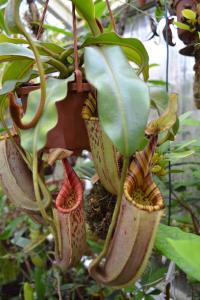 Nepenthes hurrelliana × veitchii.
Nepenthes hurrelliana × veitchii.
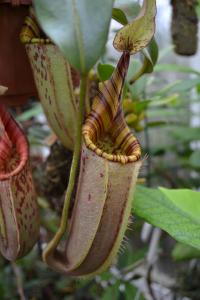 N. hurrelliana × veitchii again - I like how this hybrid has a hurrelliana-like neck and peristome, and veitchii-like pitcher body.
N. hurrelliana × veitchii again - I like how this hybrid has a hurrelliana-like neck and peristome, and veitchii-like pitcher body.
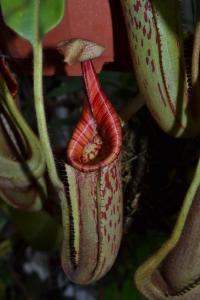 Interesting variation in colour of N. hurrelliana × veitchii peristomes.
Interesting variation in colour of N. hurrelliana × veitchii peristomes.
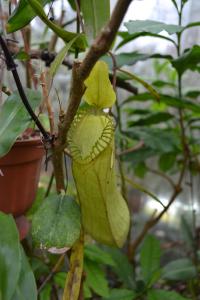 The unmistakable upper pitchers of Nepenthes hamata. This was the first time I'd seen uppers of this species in-person - they're extremely light and thin, and almost papery in texture.
The unmistakable upper pitchers of Nepenthes hamata. This was the first time I'd seen uppers of this species in-person - they're extremely light and thin, and almost papery in texture.
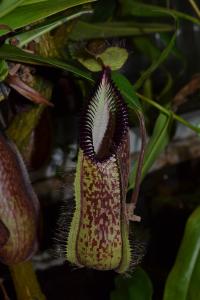 Fearsome Nepenthes hamata lower pitchers, down in the undergrowth.
Fearsome Nepenthes hamata lower pitchers, down in the undergrowth.
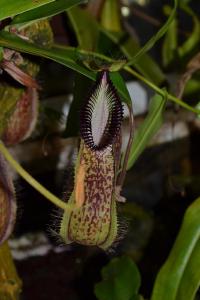 N. hamata seems a prolific producer of pitchers - there were loads at the base of this plant.
N. hamata seems a prolific producer of pitchers - there were loads at the base of this plant.
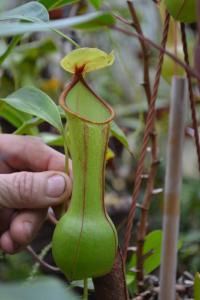 I think this was N. gracilis - this plant's upper pitchers had a distinctive bulbous base.
I think this was N. gracilis - this plant's upper pitchers had a distinctive bulbous base.
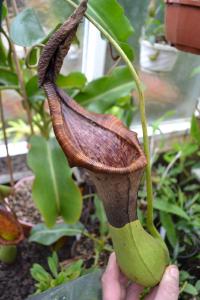 A old, browning pitcher of N. truncata x lowii - these were the exact opposite of N. hamata, tough and sturdy, almost like wood.
A old, browning pitcher of N. truncata x lowii - these were the exact opposite of N. hamata, tough and sturdy, almost like wood.
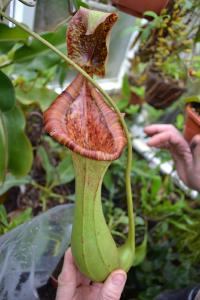 The mouth of this N. truncata x lowii pitcher was huge.
The mouth of this N. truncata x lowii pitcher was huge.
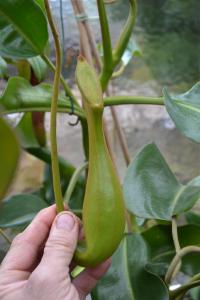 Even the younger pitchers had that tough woodiness from the N. lowii parent.
Even the younger pitchers had that tough woodiness from the N. lowii parent.
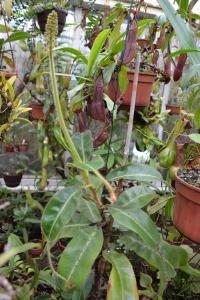 Many of Chris's plants were producing flower spikes - keep an eye out for his new seed-grown crosses!
Many of Chris's plants were producing flower spikes - keep an eye out for his new seed-grown crosses!
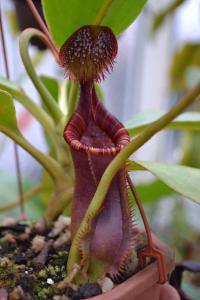 Nepenthes lowii 'Mt. Trusmadi', with the characteristic sugary excretion visible on the underside of the lid.
Nepenthes lowii 'Mt. Trusmadi', with the characteristic sugary excretion visible on the underside of the lid.
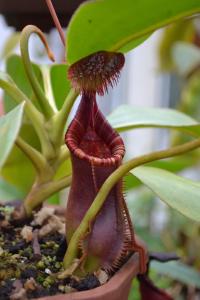 Nepenthes lowii 'Mt. Trusmadi' again - Chris remarked how strange it was that certain species go in and out of fashion. This plant could easily sell for hundreds of Euros.
Nepenthes lowii 'Mt. Trusmadi' again - Chris remarked how strange it was that certain species go in and out of fashion. This plant could easily sell for hundreds of Euros.
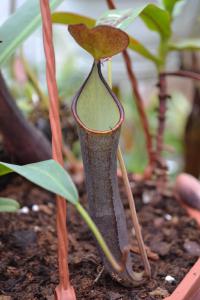 Nepenthes ramispina.
Nepenthes ramispina.
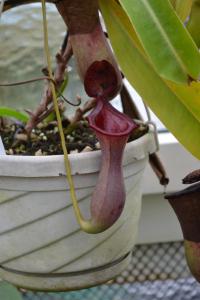 Nepenthes lowii x ventricosa.
Nepenthes lowii x ventricosa.
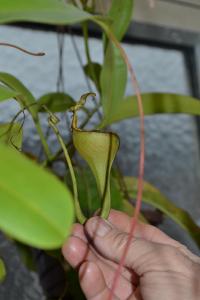 The famous wine-glass shaped upper pitchers of Nepenthes eymae.
The famous wine-glass shaped upper pitchers of Nepenthes eymae.
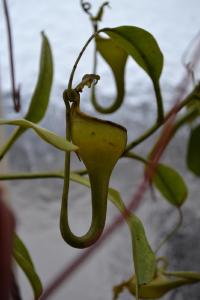 Nepenthes eymae upper pitcher looking very dainty.
Nepenthes eymae upper pitcher looking very dainty.
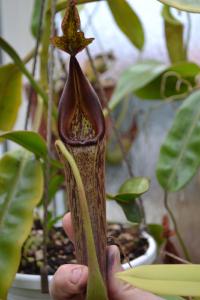 Nepenthes fusca I think.
Nepenthes fusca I think.
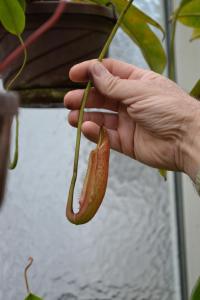 A developing pitcher on the same plant.
A developing pitcher on the same plant.
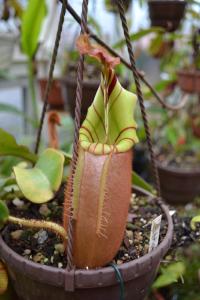 Another Nepenthes veitchii, candy striped form.
Another Nepenthes veitchii, candy striped form.
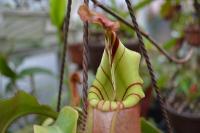 As you can probably tell, I can't get enough of this species.
As you can probably tell, I can't get enough of this species.
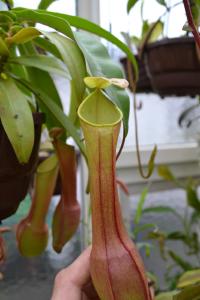 The under-appreciated Nepenthes reinwardtiana, with dinstinctive eye-spots.
The under-appreciated Nepenthes reinwardtiana, with dinstinctive eye-spots.
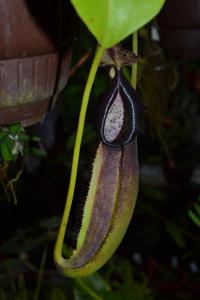 Nepenthes bongso.
Nepenthes bongso.
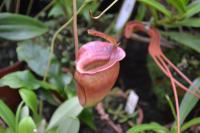 Nepenthes jacquelineae.
Nepenthes jacquelineae.
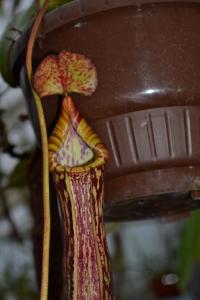 Nepenthes stenophylla.
Nepenthes stenophylla.
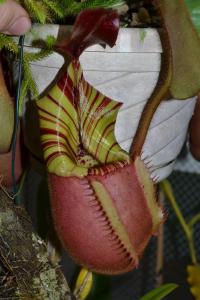 Nepenthes veitchii Bario squat form, candy striped!
Nepenthes veitchii Bario squat form, candy striped!
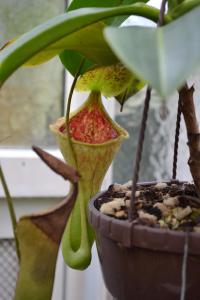 Spotted this pitcher right near the back - I think it might have been N. campanulata x lowii.
Spotted this pitcher right near the back - I think it might have been N. campanulata x lowii.
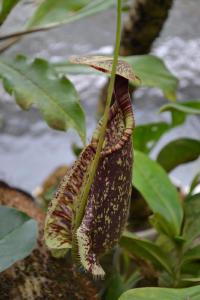 Moving into the lowland greenhouse, this is a Nepenthes rafflesiana lower pitcher.
Moving into the lowland greenhouse, this is a Nepenthes rafflesiana lower pitcher.
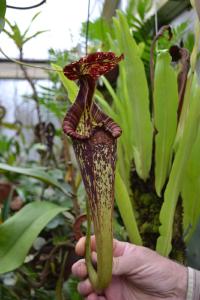 A lovely N. rafflesiana upper pitcher, with the characteristic raised lip at the front.
A lovely N. rafflesiana upper pitcher, with the characteristic raised lip at the front.
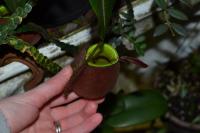 A tiny Nepenthes ampullaria - looks like the 'lime twist' clone.
A tiny Nepenthes ampullaria - looks like the 'lime twist' clone.
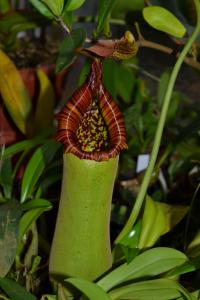 Nepenthes truncata.
Nepenthes truncata.
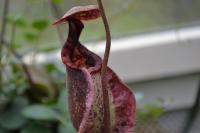 Another N. rafflesiana lower pitcher.
Another N. rafflesiana lower pitcher.
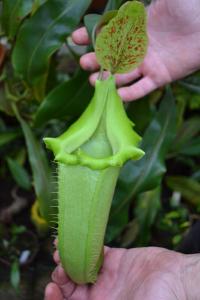 Another N. veitchii form, with bright green pitchers.
Another N. veitchii form, with bright green pitchers.
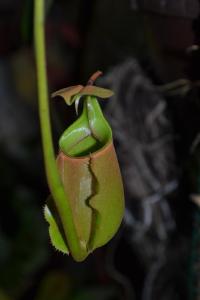 Finally, the distinctive fanged pitchers of Nepenthes bicalcarata.
Finally, the distinctive fanged pitchers of Nepenthes bicalcarata.
Propagation Methods
Today, Christian propagates all his plants from cuttings, divisions, and seeds. He has offered tissue cultured plants in the past, but found it didn’t suit his collection or his customers. “The quality was always good, but we stopped because we couldn’t get the plants we wanted. Also the Germans are mostly species growers, and there was a time they had mainly hybrids.”
His focus on seed grown plants, particularly Nepenthes species, has made Christian very well known amongst other nurseries worldwide. His approach to pollinating Nepenthes is driven largely by personal preference, but with a priority order: “First is species, second is - if possible - natural hybrids, and next is… any hybrid. Whatever happens!” Naturally, he also has to consider what’s popular at any given time: “If it sounds boring I do not pollinate it. I have a big Nepenthes hirsuta with 4 or 5 flowers at the moment, but I do not pollinate everything with N. hirsuta, because it makes no sense! Nobody wants it.”
The nursery’s seed list is always fresh. “Everything is from our own stock. We have Sarracenia, we have Dionaea, Nepenthes when we have flowering plants, we have Cephalotus. We are very correct with our seeds, we never sell anything which is older than a year. Everything is fresh.” Details of current seed stocks are available by emailing seed@carnivorsandmore.de.
The Future
While he couldn’t name a particular specimen that was his current favourite - “it’s always changing!” - he did mention that he was keen to focus his Nepenthes growing on some of the smaller species and hybrids. “N. glabrata crosses, everything mixed with N. tenuis is also very good. Also N. ventricosa - it sounds boring but the hybrids are good. N. campanulata can be very good for hybrids too.”
What about the future of CP growing in general? While Christian was keen to maintain his nursery at its current size and not expand any further, he did remark on the recent growth of the CP scene. “It’s getting bigger. The whole thing is getting bigger. CP collecting, I mean. I can see it in the customers, I can see it in their orders, and when I speak to other people - like Andreas Wistuba - they all think it’s getting bigger.”
“I think it’s also a hobby which people like to be constant in - I know many people who’ve been growing for more than 30 years.”
Many thanks to Christian. Subscribe to Tom’s Carnivores for more nursery galleries and interviews.
I've been growing carnivorous plants for over 2 decades, having been fascinated by these plants since I got my first Venus flytrap at age 10. I now have a large greenhouse to house my collection and am an avid breeder of Nepenthes pitcher plants.
- Next post: Nepenthes Guide 2018 Upgrade: In Situ Species Photos
- Previous post: 20 CP growers you should follow on Instagram


